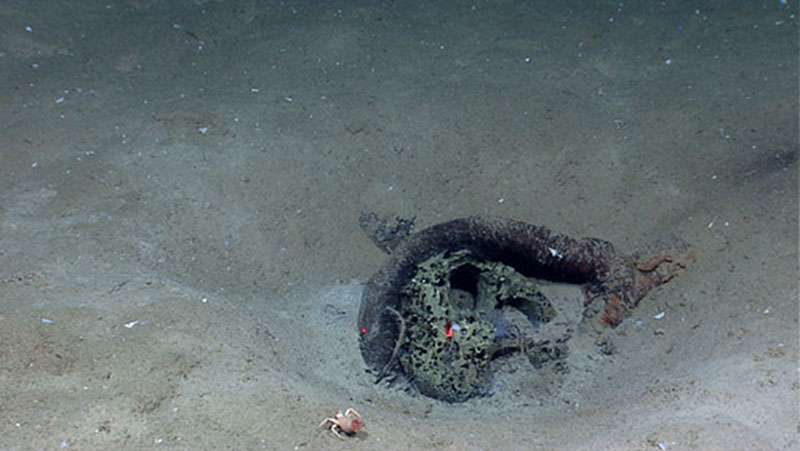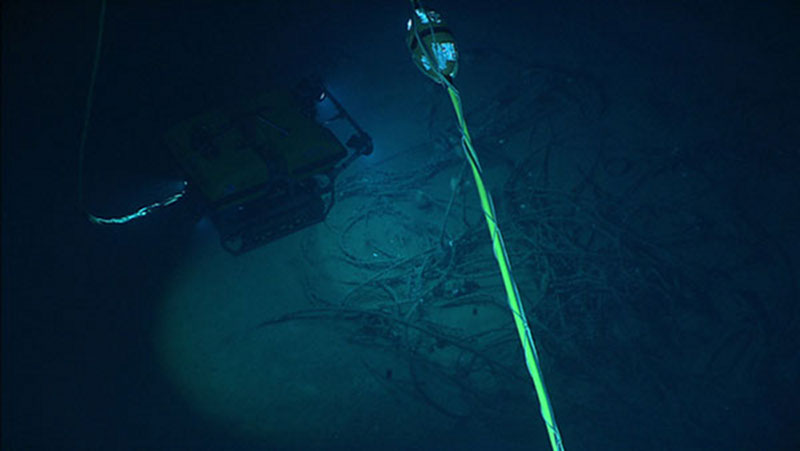
By Daniel J. Warren, C & C Technologies, Inc.
March 27, 2012

Deadeye attached to wire cable. Image courtesy of the NOAA Office of Ocean Exploration and Research, Gulf of Mexico Expedition 2012. Download larger version (jpg, 513 KB).
As I logged on to the Okeanos Explorer links this morning, I could hardly control my excitement over today’s dive on a potential shipwreck site. One would think that after 14 years of working in the Gulf of Mexico locating and documenting shipwreck sites, this would almost be routine, but it isn’t. No matter how many shipwrecks I have looked at, each one feels as exciting as the first one I explored and this time it is no different. I am ready to get the remotely operated vehicle (ROV) on the bottom and discover what this site really is.
Video footage captured by the Little Hercules ROV and camera platform during the March 27 ROV dive from NOAA Ship Okeanos Explorer during the Gulf of Mexico Expedition 2012. Video courtesy of the NOAA Office of Ocean Exploration and Research, Gulf of Mexico Expedition 2012. Download (mp4, 177.1 MB).

Side scan sonar image of the potential shipwreck site. Image courtesy of BOEM Image courtesy of BOEM. Download image (jpg, 61 KB).
Today’s site was discovered just a few months ago during a natural resources exploration of a region of the Gulf of Mexico known as the Desoto Canyon Area. The only information available on this target is a single side scan sonar image showing a ship like target roughly 18 meters (60 feet) in length and six meters (20 feet) in width. The acoustic image shows a target similar in shape to other shipwreck sites we have seen in the Gulf of Mexico, but as often as not these sites turn out to be geologic.
The countdown to the bottom begins for the first archaeology investigations for the Okeanos Explorer Program as Little Hercules and Seirios slip beneath the waves to begin their descent. It will take almost two hours to reach the seafloor roughly 2,590 meters (8,500 feet) below. During the decent, the offshore and shipboard teams go over the dive plan once more to make sure everyone is clear on the procedures. At this depth, we will only get one chance to investigate the target, so we have to get it right the first time! When the ROV reaches the bottom, time seems to slow down as I wait for the ROV crew to assess the conditions and adjust the cameras. Then I hear Tim Shank say we are moving to the target. On the sonar we see a target, almost over the planned target location. As the contact appears on the video, we all recognize the target, a pile of wire cable.

Image from Seirios showing Little Hercules over the pile of wire cable. Image courtesy of the NOAA Office of Ocean Exploration and Research, Gulf of Mexico Expedition 2012. Download larger version (jpg, 373 KB).
The wire rope or cable could be a good or bad indicator of what the site represents. Wire cable was commonly used for rigging on sailing ships in the nineteenth century. Unfortunately though, it is quite common to find bundles of discarded modern cable on the seafloor in the Gulf of Mexico. As the target gets closer my thoughts race: Is it a wreck? Or have I sent the Okeanos team on a wild goose chase for a tangle of modern debris?
Once we begin the investigation, someone spots the remnants of a cable wrapped deadeye, then a sheave, and a topmast cap. This material is definitely from a ship, but is it from a nearby shipwreck? After we finish documenting the cable area, the ROV begins a radial search for the shipwreck this rigging material may have come from. Following a pattern like the spokes on a wheel, we search 360 degrees around the cable pile but find nothing. With only a short time remaining in the dive, we strike out to explore to the northeast of the cable pile hoping to find signs of an undiscovered shipwreck. Despite our best efforts, our dive time runs out without locating the ship’s hull.
As Little Hercules and Seirios head to the surface, I am sorry to end the dive. I must admit I am somewhat disappointed we didn’t locate the whole wrecksite, but I am proud to have been part of the first marine archaeology exploration for the Okeanos Explorer Program. There are two new shipwreck dives scheduled this week and I can feel the excitement building again; almost like it is the first time I am going to explore a shipwreck.